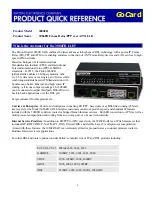
S P E C T R U M E n t e r p r i s e M a n a g e r
M o t o r o l a V a n g u a r d D e v i c e s
45 of 95
Reassembly Buffer Size
The size (in bytes) of the IP fragment reassembly
buffers. The setting must be greater than the size
of the largest IP packet to be transmitted on the
organization’s network.
Routing Table Size
The maximum number of routes that may be
stored in the IP routing table.
Default Gateway
The IP address of the default gateway this router
will use when a packet’s destination route is
otherwise unknown. The next hop must be to a
router on a directly attached network.
Default Gateway Metric
The cost metric for a transmission to this router’s
default gateway, usually given as the number of
network hops.
Default IPAddress
Unless overridden by the Internal NetMask value
described above, the Router ID is used as the
default IP address of the router. This is the
principal management address of the router, and
is the IP source address of SNMP Trap, PING and
other ICMP frames originated from the router. If
both the Router ID and Internal NetMask are left
undefined (as 0.0.0.0), the default IP address is
the IP address of the low.
Advertised Default Hops
The cost metric (usually the number of hops) that
RIP will advertise for the default route of 0.0.0.0.
A metric of 16 advertises that the default route is
unreachable.
IP Interchange Table View
Access: From the Icon Subviews menu for the
MotRouterApp Application icon, select IP
InterchangeTable.
This view contains the following two tables of
routing interchange information :
• Output Table
• Input Table
Output Table
This area of the IP Interchange Table view has the
following column headings:
Index
Number indentifying a particular output route.
NeighAS
The AS number assigned to an EGP neighbor. If
nonzero, the value must match a Neighboring AS
number entered in the IP EGP AS Information
Table. A value of 0 adds the route to the default
Output Exchange Table, which is reported to all
















































